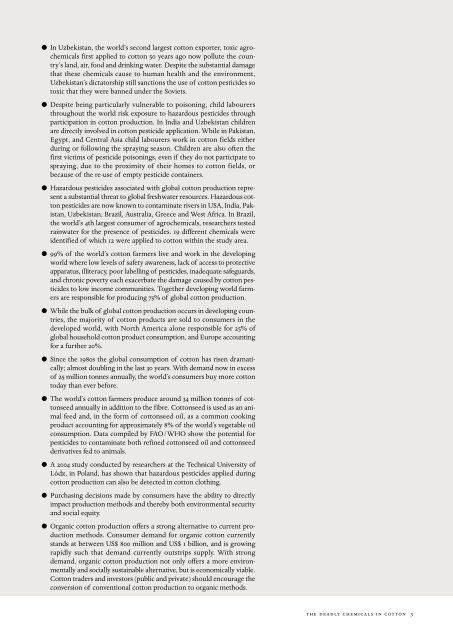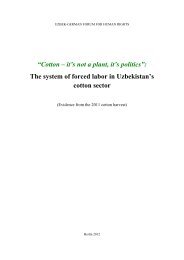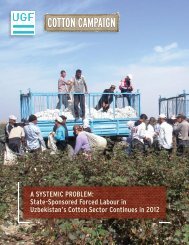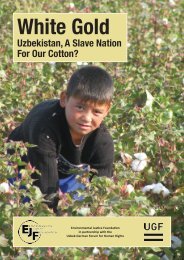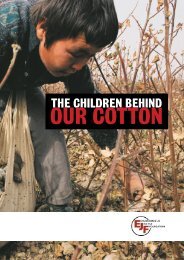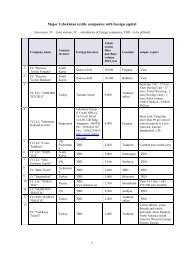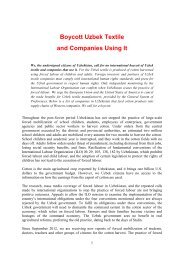The Deadly Chemicals in Cotton - Cotton Campaign
The Deadly Chemicals in Cotton - Cotton Campaign
The Deadly Chemicals in Cotton - Cotton Campaign
- No tags were found...
You also want an ePaper? Increase the reach of your titles
YUMPU automatically turns print PDFs into web optimized ePapers that Google loves.
● In Uzbekistan, the world’s second largest cotton exporter, toxic agrochemicals<br />
first applied to cotton 50 years ago now pollute the country’s<br />
land, air, food and dr<strong>in</strong>k<strong>in</strong>g water. Despite the substantial damage<br />
that these chemicals cause to human health and the environment,<br />
Uzbekistan’s dictatorship still sanctions the use of cotton pesticides so<br />
toxic that they were banned under the Soviets.<br />
● Despite be<strong>in</strong>g particularly vulnerable to poison<strong>in</strong>g, child labourers<br />
throughout the world risk exposure to hazardous pesticides through<br />
participation <strong>in</strong> cotton production. In India and Uzbekistan children<br />
are directly <strong>in</strong>volved <strong>in</strong> cotton pesticide application. While <strong>in</strong> Pakistan,<br />
Egypt, and Central Asia child labourers work <strong>in</strong> cotton fields either<br />
dur<strong>in</strong>g or follow<strong>in</strong>g the spray<strong>in</strong>g season. Children are also often the<br />
first victims of pesticide poison<strong>in</strong>gs, even if they do not participate to<br />
spray<strong>in</strong>g, due to the proximity of their homes to cotton fields, or<br />
because of the re-use of empty pesticide conta<strong>in</strong>ers.<br />
● Hazardous pesticides associated with global cotton production represent<br />
a substantial threat to global freshwater resources. Hazardous cotton<br />
pesticides are now known to contam<strong>in</strong>ate rivers <strong>in</strong> USA, India, Pakistan,<br />
Uzbekistan, Brazil, Australia, Greece and West Africa. In Brazil,<br />
the world’s 4th largest consumer of agrochemicals, researchers tested<br />
ra<strong>in</strong>water for the presence of pesticides. 19 different chemicals were<br />
identified of which 12 were applied to cotton with<strong>in</strong> the study area.<br />
● 99% of the world’s cotton farmers live and work <strong>in</strong> the develop<strong>in</strong>g<br />
world where low levels of safety awareness, lack of access to protective<br />
apparatus, illiteracy, poor labell<strong>in</strong>g of pesticides, <strong>in</strong>adequate safeguards,<br />
and chronic poverty each exacerbate the damage caused by cotton pesticides<br />
to low <strong>in</strong>come communities. Together develop<strong>in</strong>g world farmers<br />
are responsible for produc<strong>in</strong>g 75% of global cotton production.<br />
● While the bulk of global cotton production occurs <strong>in</strong> develop<strong>in</strong>g countries,<br />
the majority of cotton products are sold to consumers <strong>in</strong> the<br />
developed world, with North America alone responsible for 25% of<br />
global household cotton product consumption, and Europe account<strong>in</strong>g<br />
for a further 20%.<br />
● S<strong>in</strong>ce the 1980s the global consumption of cotton has risen dramatically;<br />
almost doubl<strong>in</strong>g <strong>in</strong> the last 30 years. With demand now <strong>in</strong> excess<br />
of 25 million tonnes annually, the world’s consumers buy more cotton<br />
today than ever before.<br />
● <strong>The</strong> world’s cotton farmers produce around 34 million tonnes of cottonseed<br />
annually <strong>in</strong> addition to the fibre. <strong>Cotton</strong>seed is used as an animal<br />
feed and, <strong>in</strong> the form of cottonseed oil, as a common cook<strong>in</strong>g<br />
product account<strong>in</strong>g for approximately 8% of the world’s vegetable oil<br />
consumption. Data compiled by FAO/WHO show the potential for<br />
pesticides to contam<strong>in</strong>ate both ref<strong>in</strong>ed cottonseed oil and cottonseed<br />
derivatives fed to animals.<br />
● A 2004 study conducted by researchers at the Technical University of<br />
Lódz, <strong>in</strong> Poland, has shown that hazardous pesticides applied dur<strong>in</strong>g<br />
cotton production can also be detected <strong>in</strong> cotton cloth<strong>in</strong>g.<br />
● Purchas<strong>in</strong>g decisions made by consumers have the ability to directly<br />
impact production methods and thereby both environmental security<br />
and social equity.<br />
● Organic cotton production offers a strong alternative to current production<br />
methods. Consumer demand for organic cotton currently<br />
stands at between US$ 800 million and US$ 1 billion, and is grow<strong>in</strong>g<br />
rapidly such that demand currently outstrips supply. With strong<br />
demand, organic cotton production not only offers a more environmentally<br />
and socially susta<strong>in</strong>able alternative, but is economically viable.<br />
<strong>Cotton</strong> traders and <strong>in</strong>vestors (public and private) should encourage the<br />
conversion of conventional cotton production to organic methods.<br />
THE DEADLY CHEMICALS IN COTTON 3


